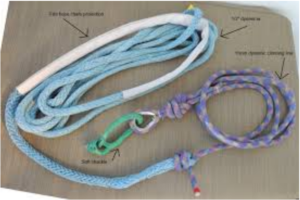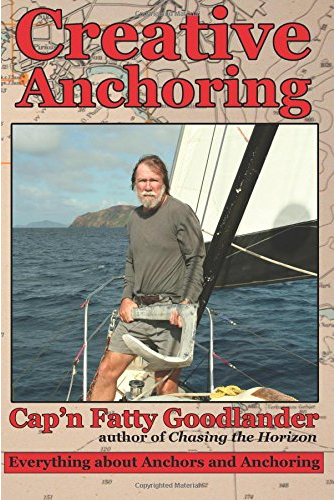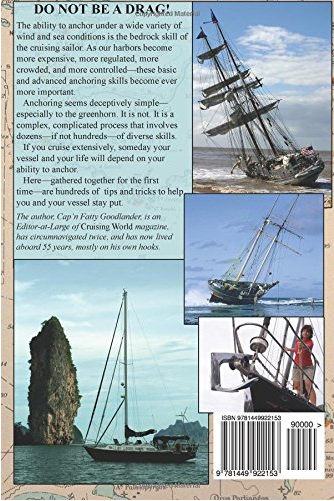Commodore’s Opinion on Anchors
Without further ado, i will offer my subjective opinions on anchor brands. i recently bought a Fortress Guardian G37 for a very good price to use as a second, or stern anchor. (Fortress recommends the G23) The new generation anchors are the best – the Danforth, CQR, and Bruce belong in the history bin along with the Fisherman. Both Rocna and Mantus recommend a 15kg or 20kg anchor for a Hughes 38 (because our boats are in between the two). Manson recommends a 35lb (15kg) anchor. i believe that weight is best spent in the anchor rather than in the chain, so the anchor should be one or two sizes larger. My bow anchor preference for the Hughes 38 is a Mantus 25kg (or even the 30kg because Mantus anchors are usually lighter than stated weight), with 45′ 5/16″ chain and 250′ of 5/8 three strand nylon. When guys at the yacht club laugh at your choice of anchor, then the size is probably right. Most of them don’t anchor much anyway, so as always “Learn from the best, ignore all the rest”
Commodore’s Opinion on Rode
The following study of the forces in anchoring concludes that the best practice is a mixed rode of heavy chain and nylon, with the chain nearest the anchor. i agree. This is because the weight of the chain causes the pull of the anchor to be more nearly horizontal than nylon alone, and the stretch of the nylon reduces the peak loads transferred to the ground tackle – both the anchor and the windlass.
In practical terms this translates for a Hughes 38 to 5/16″ chain joined to 5/8″ nylon. This can be a just about any mix of chain and nylon, but it seems best to the Commodore to have 30′ to 45′ of 5/16″ chain joined to 250′ of 5/8″ nylon. Why 30′ to 45′ of chain? Let’s presume the minimum anchoring depth of 10′ and 5′ of freeboard at bow on the Hughes 38 for a total vertical of 15′. Assuming a best practice of 5/1 you need 75′ of rode for the MINIMUM anchorage.
That works out to 30′ of chain and 45′ of nylon which is enough chain for a reasonably horizontal pull.
OR
You can use 45′ of chain and 30′ of nylon, this gives you the minimum amount of nylon for the minimum depth of water.
Quantitative Studies in Anchoring
How much rode? 5/1 for quick anchoring, 7/1 for overnite security, and 10/1 for storms. Don’t forget to add for tides and freeboard of boat at bow to the depth.
Commodore’s Opinion on Snubbers
For those that use snubbers on their all chain rode, here is a formula to figure the diameter of the snubber.
Snubber diameter = Displacement^0.4 x 0.00832
where diameter is in inches and displacement is in pounds. For two-leg bridles, multiply the final diameter by 70 percent. (One leg will occasionally carry the load, but this is offset by reduced yawing.) This works out to a .384″ (3/8″) single snubber for a Hughes 38 of 14,500 lbs or .266 or 1/4″ for a two-leg bridle, usually used with multihulls, but any boat can benefit. Snubber Size
Another Snubber Idea
The Snubber Line by Evan Starzinger “With snubbers the objective is to get maximum stretch with minimum chafe. I have copied an idea from New England Ropes and created a line with very chafe resistant dyneema (blue line) from the deck cleat to just beyond the bow roller, and then with stretchy dynamic rock climbing line from the bow roller to the soft shackle.
Above is a picture of version #1.” Thanks to Evan for this new method. In the past we have used all nylon snubber to ensure proper stretch between the anchor chain and the boat. That created its own chafe points and noise in a rough anchorage. But by using a piece of dyneema rode (almost zero stretch) attached to the boat and running over the bow roller and then tied to the nylon 3 strand we have eliminated all the chafe and noise we have experienced in the past 25 years. It’s been 6 seasons now using no chafe gear! Plus no squeaking or chain rattling! Further information & discussion can be found at
Cruisers Forum Discussion on Snubbers
http://www.cruisersforum.com/forums/f118/snubber-version-3-a- 110974.html
Practical Sailor Article on Snubbers and Bridles
Commodores Opinion on Windlasses
More Resources
Dashew Right Rode for Anchoring
Peter Smith (Developer of the Rocna Anchor) has a good discussion on rodes here:
Chains, Ropes and Anchors A good source of anchoring equipment information
Creative Anchoring by Fatty Goodlander
Fatty Goodlander on SV Wildcard recommends a Rocna 20 (kg) anchor with 200 ft of 5/16 (G4) chain for a Hughes 38.
SV Verdia – a well equipped Hughes 38 out of Vancouver uses 50lb Manson plow with 200′ 5/16 (G4) chain



